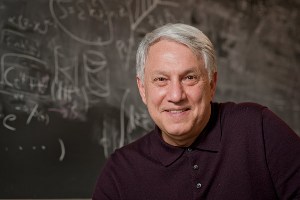May 30 2014
Andrei Linde, the Harold Trap Friis Professor of Physics at Stanford, has been awarded the 2014 Kavli Prize in Astrophysics for his work in developing the theory of cosmic inflation, the theory that explains the origin and structure of the universe.
 Stanford physics Professor Andrei Linde received the 2014 Kavli Prize in Astrophysics along with his fellow pioneers in the theory of cosmic inflation, Alan Guth and Alexei Starobinsky.
Stanford physics Professor Andrei Linde received the 2014 Kavli Prize in Astrophysics along with his fellow pioneers in the theory of cosmic inflation, Alan Guth and Alexei Starobinsky.
Linde shares the award – and the accompanying $1 million prize – with fellow inflation pioneers Alan Guth, a professor of physics at MIT, and Alexei Starobinsky, a cosmologist at the Landau Institute for Theoretical Physics of the Russian Academy of Sciences.
The Kavli Prize, bestowed each year by the Norwegian Academy of Science and Letters, is a top scientific prize that recognizes scientists for their seminal advances in the fields of astrophysics, nanoscience and neuroscience.
The theory of cosmic inflation has revolutionized our thinking about how the universe came to be after the Big Bang. The theory extends our physical description of the cosmos all the way back to when the universe was only a tiny fraction of a second old.
According to the theory, very soon after the universe came into existence, it underwent a short-lived phase of exponential expansion, during which it expanded by a huge factor – hence the name inflation. The consequences of this episode orchestrated the evolution of the cosmos.
During the 1970s, Guth, Linde and Starobinsky worked independently on models of the early universe. In 1980, Guth, at the time a scientist at what is now the SLAC National Accelerator Laboratory at Stanford, proposed inflation theory. Linde later suggested modifications to Guth's theory to overcome some of its shortcomings, creating what was called "new inflation."
Linde soon put forward a more general theory, called chaotic inflation, which encompasses most of the inflation scenarios being studied today. Linde has continued to push the boundaries of inflation theory, proposing ever more exotic versions – including a scenario that could have led to the formation of multiple universes.
Inflation theory took a step toward validation earlier this year when the principal investigators of the BICEP2 experiment – including Chao-Lin Kuo, an assistant professor of physics at Stanford – announced that they had indirectly detected gravitational waves, ripples in space-time that were created in the first moments of the universe. Although the discovery still requires independent confirmation, gravitational waves are a key prediction of the processes outlined in inflation theory, and their detection would shore up its place in physics.
Linde is the second Stanford professor to earn a Kavli Prize, which began in 2008. Thomas Sudhof, a professor in the School of Medicine's Department of Molecular and Cellular Physiology, shared the 2010 Kavli Prize for Neuroscience for his role in "discovering the molecular basis of neurotransmitter release."